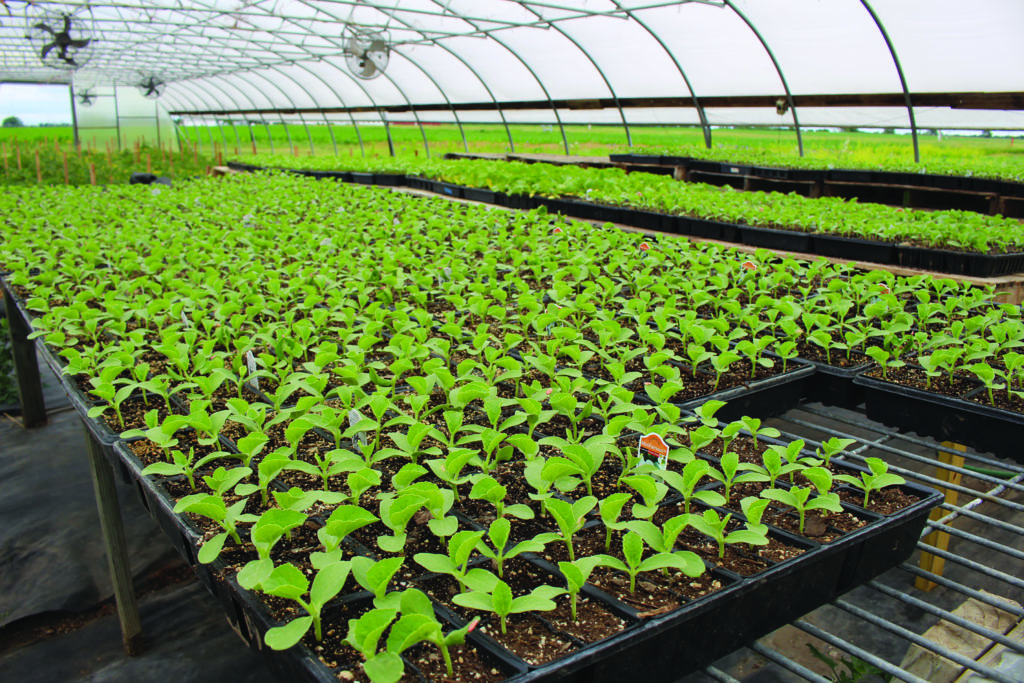

Jun 18, 2019Ag census: Greenhouse tomato space soars
Call it the age of the greenhouse tomato.
The last decade has been good to that growing technique, according to the 2017 Census of Agriculture. Greenhouse space is up across the U.S. overall, and vegetable growers remain in a good position to compete for those glass houses despite the increase in hemp and cannabis production. That’s in an age when vegetable growers as an industry are doing less with more: Growing more value on fewer acres.
The USDA’s agriculture survey – which is conducted every five years – provides some statistical snapshots of the situation.
In May, Brandon Johnson wrote in an article for the USDA’s Economic Research Service discussing how the total value of vegetables grew about 16% between the 2012 and 2017 censuses – despite a decrease in the number of acres covered.
“Greenhouse tomato production, however, has risen steadily since 2007, recording a 25.6% increase between 2007 and 2012 and a 15.7% increase between 2012 and 2017,” Johnson wrote. That’s in contrast to fresh field-grown tomatoes, whose acreage counted by the census dropped by 27% from 2012 to 2017.
There are more vegetable growers planting in more greenhouses. The 2017 census counted 10,849 greenhouse vegetable farms – a 19% increase from 8,750 in 2012. In 2017, there were more than 112 million square feet, or 2,584 acres, of space dedicated to growing vegetables or fresh-cut herbs – up nearly 15% from 2012’s 2,250 acres.
That was as of 2017. Since then, a steady stream of anecdotal evidence, including publicity about new mega-greenhouses opening, has made its way to trade media.

In one notable move, fast food giant Wendy’s in 2018 committed to only vine-ripened greenhouse tomatoes. In March 2019, startup AppHarvest announced $82 million in funding from Equilibrium Capital to build a 60-acre greenhouse in Morehead, Kentucky.
“We see a tremendous opportunity for the future of controlled-environment foods,” Equilibrium Chairman Dave Chen said in a released statement. “Farming is undergoing a profound shift to a capital and production infrastructure intensive model to meet the demands of consumers, retailers and food processors for more reliable, year-round, fresher, and sustainable foods.”
In the West, growers are becoming concerned with competition for greenhouse space. Cut flower producers vying for a greenhouse lease can often outbid vegetable growers. The hemp and cannabis industries, which were not counted in the federal census, also have grown.


Photo: UC Davis
“You can grow a hell of a lot of volume of cannabis, a lot of value of cannabis, in not much space,” said Daniel Sumner, director of the University of California’s Agricultural Issues Center. “So, we did a project with the cut flower people where they were saying, ‘Gee, the cannabis guys are taking the greenhouses.’”
Sumner found that while some greenhouses were changing hands, it wasn’t enough to affect the industry as a whole.
“What our study showed was, yeah, they’ll get every greenhouse they want. They grow $5 million worth of cannabis in a greenhouse,” he said. “But we said, gee, don’t worry about them taking all the greenhouses. Any greenhouse they want, they got, because they got the money, but it’s not going to be a huge quantity.”
Above: USDA researchers indicate greenhouse tomato production has risen steadily in the past 12 years. Photos: Gary Pullano
Drought not an issue
Sumner said that most vegetable growers in California seem unaffected by the droughts of recent years.
“The processing tomato industry, which is national, is going along,” he said. “Lots of people talked about the drought here in California that lasted for a while, but it didn’t really affect much in the way of the vegetable guys, because they generate enough revenue that they get the water if they want it. So they may leave some cotton land or some alfalfa or something idle in the southern (San) Joaquin Valley, but you’re never going to leave your carrot land idle.”
He said that the berry crops have only increased in coastal California (Monterey, Santa Cruz and Ventura counties) and that has made business more difficult for vegetable growers.
“They generate a lot of revenue from berries and compete for land and water and other resources with the vegetable guys,” he said. They also compete for the dwindling labor supply.
“The joke I like is, ‘Farm workers are getting a year older every year,’” Sumner said. “But we’re not talking about the individual. So few people are coming in as young people that the average age is steadily going up. And it’s hard work. You don’t have to be 50 to feel your back when you’re bending over harvesting asparagus or something. So every grower is trying to figure out ways to stretch that labor force, make the job less onerous and higher wages if they can do it, to keep workers out there longer in terms of years.”
– Stephen Kloosterman, associate editor














